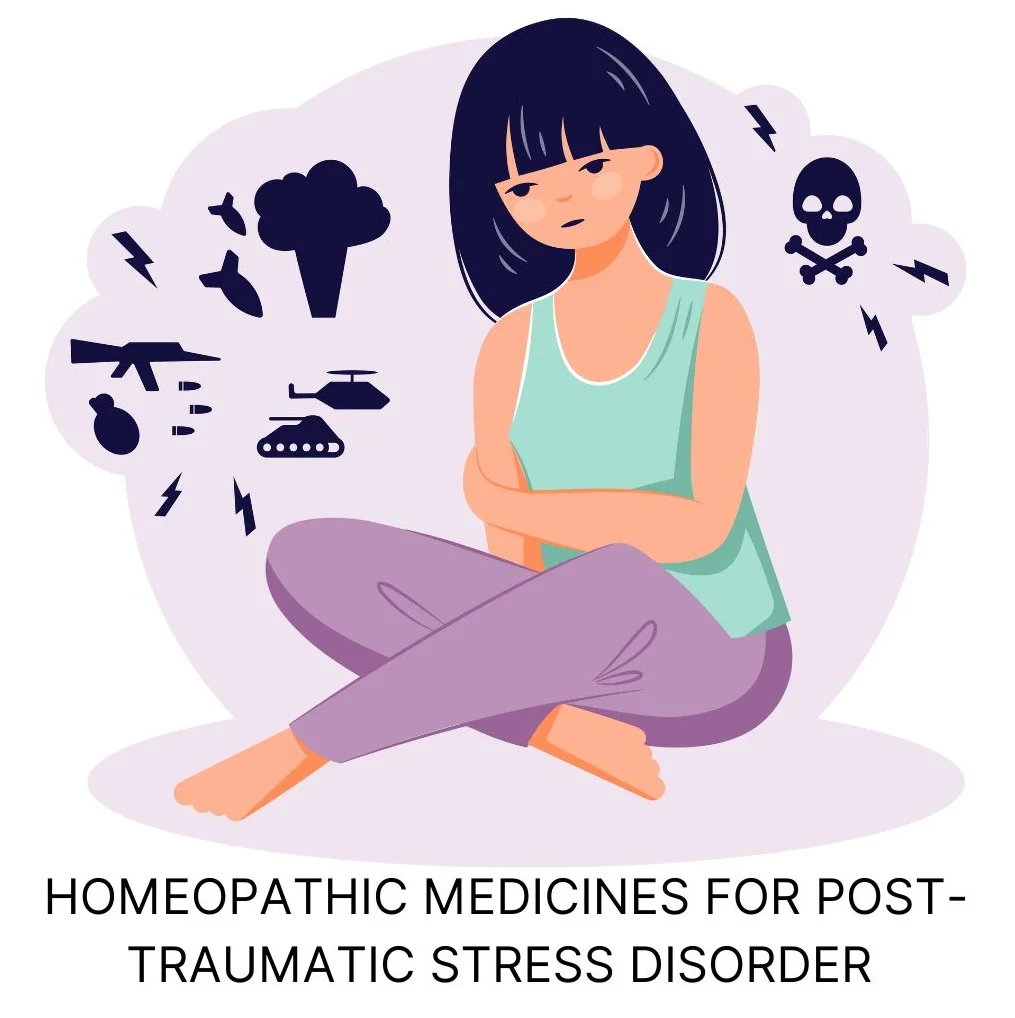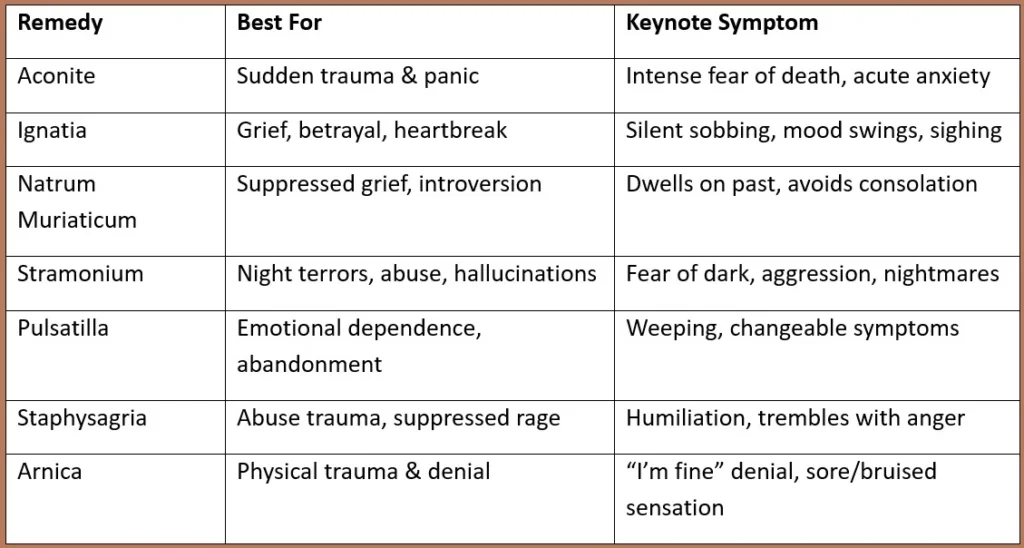Post-Traumatic Stress Disorder (PTSD) is a mental health condition that may develop after experiencing or witnessing a traumatic event such as war, natural disasters, abuse, assault, or accidents.
While conventional therapies like counselling and medication remain important, many individuals seek holistic healing options like homeopathy for long-term emotional support and inner balance.
In this blog post, we explore how homeopathic remedies offer a gentle, non-toxic, and personalized approach to healing PTSD.
Table of Contents
ToggleUNDERSTANDING PTSD IN A HOLISTIC WAY
PTSD can manifest in several ways:
- Recurring flashbacks or nightmares
- Hypervigilance and heightened startle response
- Emotional numbness
- Insomnia or disturbed sleep
- Irritability or anger outbursts
- Avoidance of people, places, or activities that are reminders of the trauma
Homeopathy approaches PTSD not just as a mental disorder, but as an imbalance in the vital force caused by an emotional or psychological shock.
It aims to stimulate the body’s self-healing power, addressing the root cause rather than merely suppressing symptoms.

TOP HOMEOPATHIC REMEDIES FOR PTSD (POST-TRAUMATIC STRESS DISORDER)
🧠 Note: The best remedy always depends on the totality of symptoms—your physical, emotional, and psychological state, past history, and personality. Homeopathy is not one-size-fits-all, and I always recommend consulting a qualified homeopath for individualized care.
1. Aconitum Napellus – For Acute Shock & Sudden Panic
Best Suited For: Individuals who have experienced a sudden trauma such as a car accident, natural calamity, surgical shock, or a life-threatening incident.
They may show intense fear of death, extreme restlessness, and panic attacks soon after the event.
Psychological Picture
- Highly alert and jumpy
- Feels like something terrible is about to happen
- Sudden outbursts of fear or terror
- Refuses to sleep or be left alone at night
Keynote Symptoms
- Palpitations, trembling, dry mouth
- Fear of death (especially at night)
- Acute insomnia and claustrophobia
- Cold sweat with anxiety
Dosage
- 30C or 200C, once or twice daily in acute phases.
- Reduce frequency as symptoms improve.
- In chronic PTSD cases, consult a homeopath before repetition.
2. Ignatia Amara – For Grief, Emotional Shock, and Suppression
Best Suited For: Sensitive individuals who are grieving in silence after losing a loved one, facing betrayal, or going through emotional heartbreak.
They tend to internalize pain, suppress tears, and feel misunderstood.
Psychological Picture
- Sighs deeply often
- Holds back tears in public
- Moods shift rapidly (laughing, then crying)
- Feels a lump in the throat under emotional stress
Keynote Symptoms
- Grief-related insomnia
- Headaches from emotional suppression
- Aversion to consolation
- Twitching or jerking of muscles with emotions
Dosage
- 200C, once every few days in deep emotional trauma
- For milder expressions, 30C daily or every alternate day
- Avoid frequent repetition unless guided by a practitioner
3. Natrum Muriaticum – For Silent, Introverted Suffering
Best Suited For: People who suppress their grief and avoid emotional exposure. Often linked to childhood emotional neglect, broken trust, or heartbreak.
Psychological Picture
- Withdrawn, avoids emotional discussions
- Weeps alone; never in front of others
- Remembers past emotional wounds vividly
- Highly sensitive to criticism or rejection
Keynote Symptoms
- Aversion to sympathy or being consoled
- Headaches after emotional stress
- Sleeplessness from ruminating thoughts
- Dryness of lips, craving for salt
Dosage
- 200C, once weekly in chronic emotional trauma
- Do not repeat unnecessarily—watch for shifts in emotional tone
- Ideal to use under guidance in long-standing PTSD cases
4. Stramonium – For Night Terrors and Fear of Darkness
Best Suited For: PTSD following severe fright, violence, or abuse. Especially effective in children or adults with intense nightmares, hallucinations, and fear of darkness or being alone.
Psychological Picture
- Terrified expressions
- Aggressive or erratic behaviour
- Clings to people out of fear
- Screaming or talking during sleep
Keynote Symptoms
- Night terrors with violent reactions
- Fear of tunnels, dark rooms, mirrors
- Stammering or convulsions in extreme fear
- Dry mouth with trembling and staring
Dosage
- 200C, once weekly or as needed after night terrors
- Lower potencies like 30C, daily in milder cases
- Always observe closely in cases with aggression or fear psychosis
5. Pulsatilla Nigricans – For Emotional Dependency & Insecurity
Best Suited For: Individuals—especially women and children—who become emotionally needy and clingy after trauma.
They may exhibit a fear of abandonment and weep easily, craving attention and affection.
Psychological Picture
- Mild, affectionate nature
- Seeks reassurance constantly
- Feels worse in warm, closed environments
- Emotionally and physically changeable
Keynote Symptoms
- Crying spells, especially in the evening
- Mood swings and oversensitivity
- Feels better in fresh air and with support
- Aversion to fatty food, thirstless
Dosage
- 30C, once or twice daily based on emotional intensity
- Can be given in 200C weekly for deeper trauma cases
- Needs careful observation due to emotionally fluid nature
6. Staphysagria – For Abuse Trauma & Suppressed Anger
Best Suited For: People with a history of sexual abuse, humiliation, or emotional suppression, especially where there’s repressed rage hidden behind a soft, mild demeanor.
Psychological Picture
- Soft-spoken, avoids conflict
- Internalizes anger until it bursts
- Easily offended, may tremble with suppressed rage
- May suffer from psychosomatic disorders like IBS, tension headaches
Keynote Symptoms
- Suppressed emotions leading to physical ailments
- Teeth grinding, headaches, menstrual issues
- Ailments from indignation or being insulted
- Sexual dysfunction or hypersensitivity post-abuse
Dosage
- 200C, once a week or biweekly in deeper cases
- For emotional suppression with psychosomatic symptoms, 30C once or twice daily
- Should be administered mindfully—can trigger emotional release
7. Arnica Montana – For PTSD from Physical Trauma or Accidents
Best Suited For: PTSD triggered after physical injury, surgery, or accidents.
The person feels “bruised” emotionally and physically, often denying pain or saying “I’m fine” when they’re not.
Psychological Picture
- Wants to be left alone
- Refuses medical help despite visible distress
- Has vivid dreams or relives the trauma
- Hypervigilance about health after an accident
Keynote Symptoms
- Fear of being touched or approached
- Sore, bruised feeling all over the body
- Recurrent nightmares of injury
- Mental trauma after physical shock
Dosage
- 30C to 200C, depending on the intensity
- For physical and emotional trauma, 200C weekly or after a triggering event
- Works well alongside remedies like Aconite or Hypericum for full-spectrum healing

WHY CHOOSE HOMEOPATHY FOR PTSD?
- Non-addictive and free from chemical side effects
- Treats the individual, not the disease
- Addresses emotional, physical, and behavioral layers of trauma
- Complements psychotherapy, counselling, and lifestyle changes
- Offers deep, long-lasting healing rather than temporary relief
LIFESTYLE TIPS TO SUPPORT PTSD RECOVERY
Healing from PTSD is a gentle, layered journey, and while homeopathic remedies can bring balance to your emotional and physical state, your daily lifestyle plays a vital role in supporting long-term recovery.
Here are some nurturing practices to help create a safe and healing environment for your mind and body:
🧘♀️ Practice Mindfulness & Grounding Exercises
Mindfulness helps anchor your awareness in the present moment, especially when trauma pulls you into past memories.
- Try simple breathing techniques, such as box breathing (4-4-4-4) or 5-4-3-2-1 grounding to calm anxiety.
- Yoga, body scanning, and mindful walks can help reestablish the mind-body connection.
🛌 Prioritize Sleep & Establish a Gentle Routine
PTSD often disrupts sleep cycles and daily rhythms.
- Aim for 7–8 hours of quality sleep, going to bed and waking up at the same time each day.
- Create a soothing bedtime ritual (warm bath, herbal tea, or soft music) to ease into rest.
- Routines create a sense of predictability and safety—even simple morning rituals can make a difference.
🤝 Seek Support – You Are Not Alone
Talking about your experience can be one of the most healing steps.
- Consider joining a support group for PTSD, trauma survivors, or grief recovery.
- Professional talk therapy (especially trauma-informed or somatic-based approaches) can help unpack layers safely.
- Even one trusted person to confide in can offer deep emotional relief.
🎨 Use Creative Expression as Emotional Release
Sometimes, words aren’t enough to process trauma—and that’s okay.
- Art, journaling, music, dance, or even gardening can act as emotional outlets.
- Keep a daily journal to track your moods, dreams, or triggers—it builds self-awareness and helps notice patterns.
- Creativity helps you process without pressure and reconnect with joy.
📵 Protect Your Emotional Space – Limit Stressful Media
Constant exposure to disturbing news or overstimulating content can increase anxiety and hypervigilance.
- Set boundaries around social media and news—especially before bedtime.
- Choose content that soothes, uplifts, or inspires healing (nature documentaries, music therapy, motivational talks).
- Remember: You’re allowed to guard your peace.
🥗 Nourish Your Body – Balanced Diet & Gentle Movement
Physical well-being directly impacts emotional resilience.
- Eat whole, calming foods: warm soups, seasonal fruits, grounding grains, and healthy fats.
- Avoid stimulants (caffeine, refined sugar) that may increase anxiety or disrupt sleep.
- Choose gentle physical activity like walking, stretching, yoga, or swimming. Movement releases stored tension and boosts mood-enhancing chemicals like serotonin and dopamine.
🧴 Dosage & Safety
Homeopathy is safe when prescribed correctly.
Most PTSD cases require constitutional treatment by an experienced homeopath.
However, in acute phases:
- Use a 30C or 200C potency (as advised)
- Avoid self-prescribing repeatedly without monitoring changes
- Reassess after a few doses and adjust based on symptoms
Frequently Asked Questions: PTSD & Homeopathy
Q: How soon can I expect results from homeopathic remedies for PTSD?
A: Results vary by individual. Some experience improvement within days, especially in acute trauma cases (e.g., Aconite or Ignatia after a shock or loss), while others may need weeks or months of deeper constitutional treatment (e.g., Natrum Muriaticum or Staphysagria). Close monitoring of emotional shifts and dosage adjustments are key.
Q: Are these remedies safe for children or elderly individuals with PTSD?
A: Yes, when prescribed correctly, homeopathic remedies are safe for all age groups—including infants, children, and the elderly. Always use age-appropriate potencies (typically 30C) and seek guidance for ongoing support.
Q: Can I take homeopathic remedies alongside psychiatric medications?
A: Yes. Homeopathy is non-interfering with conventional psychiatric medicines and may help reduce dependence over time under supervision.
Always inform your psychiatrist or primary healthcare provider before making any changes to your medication routine.
Q: How do I choose the right remedy if I resonate with more than one?
A: Look at the core emotional pattern and modalities (what makes you feel better or worse). For example:
- If your trauma includes fear and night terrors → Stramonium
- If your trauma involves loss and silent weeping → Natrum Muriaticum
- If your trauma is rooted in abuse or humiliation → Staphysagria
Consult a qualified homeopath for an in-depth case-taking and constitutional matching.
Q: What should I do if I feel worse after taking a remedy?
A: Temporary emotional aggravation can occur as part of a healing response. However, if symptoms intensify or become uncomfortable:
- Stop further dosing
- Note down emotional or physical changes
- Contact a homeopath for assessment
Overdosing or unnecessary repetition can lead to symptom provocation—homeopathy values minimal doses for maximum effect.
🌱 Final Thought
Recovery is not linear, and you do not have to do everything at once. Choose one or two practices that feel most approachable and build slowly.
Healing doesn’t mean the damage never existed. It means the damage no longer controls your life.
Even small changes—done consistently—can lead to deep inner shifts.
